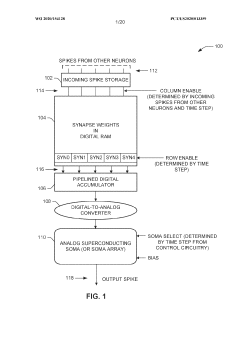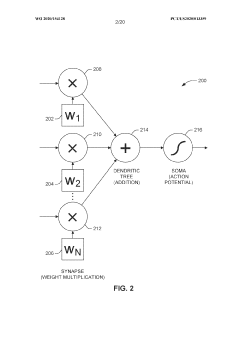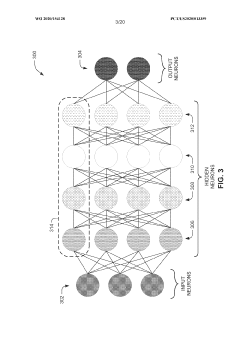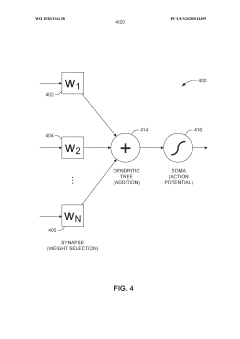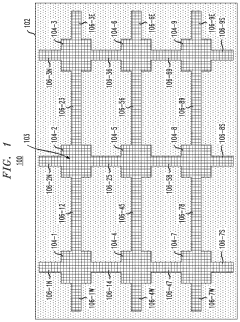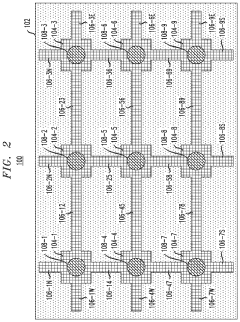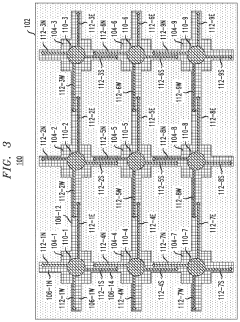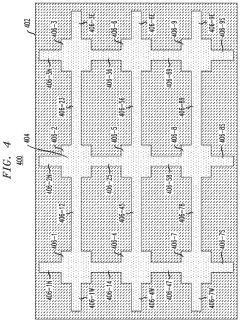Understanding neuromorphic material impacts on neural coding
SEP 19, 20259 MIN READ
Generate Your Research Report Instantly with AI Agent
Patsnap Eureka helps you evaluate technical feasibility & market potential.
Neuromorphic Materials Evolution and Research Objectives
Neuromorphic computing represents a paradigm shift in computational architecture, drawing inspiration from the structure and function of biological neural systems. The evolution of this field has been marked by significant advancements in material science, transitioning from traditional silicon-based technologies to novel neuromorphic materials that more accurately mimic the behavior of biological neurons and synapses.
The journey of neuromorphic materials began in the late 1980s with Carver Mead's pioneering work on analog VLSI systems that emulated neural functions. These early systems utilized conventional semiconductor technologies but arranged in configurations that simulated neural networks. The 1990s witnessed the emergence of specialized hardware implementations, primarily focused on silicon-based neuromorphic chips that could perform basic neural computations.
A significant breakthrough occurred in the early 2000s with the development of memristive devices, which demonstrated the ability to retain memory without power, similar to biological synapses. This period marked the transition from purely electronic components to materials with inherent neuromorphic properties, including phase-change materials, ferroelectric materials, and various oxide-based memristors.
The last decade has seen an acceleration in neuromorphic material innovation, with research expanding into organic electronics, 2D materials like graphene, and complex oxide heterostructures. These materials exhibit properties such as spike-timing-dependent plasticity (STDP), a fundamental mechanism for learning in biological systems, and can operate at energy levels approaching those of the human brain.
Current research objectives in neuromorphic materials focus on several key areas. First, enhancing the energy efficiency of neuromorphic systems to approach the remarkable efficiency of biological neural networks, which operate at orders of magnitude lower power than conventional computing systems. Second, improving the scalability of neuromorphic architectures to enable the creation of large-scale neural networks capable of complex cognitive tasks.
Another critical objective is developing materials with enhanced plasticity and adaptability, allowing for more sophisticated learning algorithms and better approximation of biological neural coding mechanisms. Researchers are also working on integrating sensing capabilities directly into neuromorphic materials, creating systems that can process sensory information in a manner similar to biological sensory organs.
The ultimate goal of neuromorphic material research is to create computing systems that not only mimic the structure of the brain but also replicate its remarkable capabilities in pattern recognition, adaptation, and energy efficiency. This would enable transformative applications in artificial intelligence, robotics, and brain-computer interfaces, potentially leading to computing systems that can learn and evolve in ways similar to biological intelligence.
The journey of neuromorphic materials began in the late 1980s with Carver Mead's pioneering work on analog VLSI systems that emulated neural functions. These early systems utilized conventional semiconductor technologies but arranged in configurations that simulated neural networks. The 1990s witnessed the emergence of specialized hardware implementations, primarily focused on silicon-based neuromorphic chips that could perform basic neural computations.
A significant breakthrough occurred in the early 2000s with the development of memristive devices, which demonstrated the ability to retain memory without power, similar to biological synapses. This period marked the transition from purely electronic components to materials with inherent neuromorphic properties, including phase-change materials, ferroelectric materials, and various oxide-based memristors.
The last decade has seen an acceleration in neuromorphic material innovation, with research expanding into organic electronics, 2D materials like graphene, and complex oxide heterostructures. These materials exhibit properties such as spike-timing-dependent plasticity (STDP), a fundamental mechanism for learning in biological systems, and can operate at energy levels approaching those of the human brain.
Current research objectives in neuromorphic materials focus on several key areas. First, enhancing the energy efficiency of neuromorphic systems to approach the remarkable efficiency of biological neural networks, which operate at orders of magnitude lower power than conventional computing systems. Second, improving the scalability of neuromorphic architectures to enable the creation of large-scale neural networks capable of complex cognitive tasks.
Another critical objective is developing materials with enhanced plasticity and adaptability, allowing for more sophisticated learning algorithms and better approximation of biological neural coding mechanisms. Researchers are also working on integrating sensing capabilities directly into neuromorphic materials, creating systems that can process sensory information in a manner similar to biological sensory organs.
The ultimate goal of neuromorphic material research is to create computing systems that not only mimic the structure of the brain but also replicate its remarkable capabilities in pattern recognition, adaptation, and energy efficiency. This would enable transformative applications in artificial intelligence, robotics, and brain-computer interfaces, potentially leading to computing systems that can learn and evolve in ways similar to biological intelligence.
Market Analysis for Brain-Inspired Computing Technologies
The brain-inspired computing market is experiencing unprecedented growth, driven by the convergence of neuroscience, materials science, and artificial intelligence. Current market valuations place this sector at approximately $2.5 billion in 2023, with projections indicating a compound annual growth rate of 24% through 2030, potentially reaching $11.4 billion by decade's end. This remarkable trajectory is fueled by increasing demands for energy-efficient computing solutions capable of handling complex cognitive tasks.
Neuromorphic materials, particularly those impacting neural coding mechanisms, represent a critical subsegment with distinctive market characteristics. These materials enable computing architectures that mimic biological neural networks, offering significant advantages in power efficiency and parallel processing capabilities. The market for specialized neuromorphic materials is currently valued at approximately $450 million, with memristive technologies accounting for nearly 40% of this value.
Key market drivers include the exponential growth in data processing requirements across industries, particularly in edge computing applications where power constraints are significant. Healthcare applications represent the fastest-growing vertical, with neuromorphic solutions increasingly deployed in medical imaging analysis, brain-computer interfaces, and personalized medicine algorithms.
Geographically, North America dominates the market with approximately 42% share, followed by Europe (28%) and Asia-Pacific (24%). However, the Asia-Pacific region demonstrates the highest growth rate at 29% annually, primarily driven by substantial investments in China, South Korea, and Japan.
The customer landscape is segmented into three primary categories: research institutions (35%), technology corporations (40%), and defense/aerospace entities (25%). Each segment demonstrates distinct purchasing patterns and application requirements, with research institutions prioritizing flexibility and technology corporations emphasizing scalability and integration capabilities.
Market challenges include the significant capital requirements for neuromorphic material development, regulatory uncertainties surrounding novel computing architectures, and the technical complexity of integrating these solutions into existing computing ecosystems. Additionally, the interdisciplinary nature of neuromorphic computing necessitates collaboration across traditionally separate domains, creating organizational challenges for market participants.
Pricing models remain in flux, with most solutions currently commanding premium pricing due to their specialized nature and limited production scales. However, industry analysts anticipate price normalization as manufacturing processes mature and competition intensifies, potentially expanding market accessibility beyond current high-value applications.
Neuromorphic materials, particularly those impacting neural coding mechanisms, represent a critical subsegment with distinctive market characteristics. These materials enable computing architectures that mimic biological neural networks, offering significant advantages in power efficiency and parallel processing capabilities. The market for specialized neuromorphic materials is currently valued at approximately $450 million, with memristive technologies accounting for nearly 40% of this value.
Key market drivers include the exponential growth in data processing requirements across industries, particularly in edge computing applications where power constraints are significant. Healthcare applications represent the fastest-growing vertical, with neuromorphic solutions increasingly deployed in medical imaging analysis, brain-computer interfaces, and personalized medicine algorithms.
Geographically, North America dominates the market with approximately 42% share, followed by Europe (28%) and Asia-Pacific (24%). However, the Asia-Pacific region demonstrates the highest growth rate at 29% annually, primarily driven by substantial investments in China, South Korea, and Japan.
The customer landscape is segmented into three primary categories: research institutions (35%), technology corporations (40%), and defense/aerospace entities (25%). Each segment demonstrates distinct purchasing patterns and application requirements, with research institutions prioritizing flexibility and technology corporations emphasizing scalability and integration capabilities.
Market challenges include the significant capital requirements for neuromorphic material development, regulatory uncertainties surrounding novel computing architectures, and the technical complexity of integrating these solutions into existing computing ecosystems. Additionally, the interdisciplinary nature of neuromorphic computing necessitates collaboration across traditionally separate domains, creating organizational challenges for market participants.
Pricing models remain in flux, with most solutions currently commanding premium pricing due to their specialized nature and limited production scales. However, industry analysts anticipate price normalization as manufacturing processes mature and competition intensifies, potentially expanding market accessibility beyond current high-value applications.
Current Challenges in Neuromorphic Material Implementation
Despite significant advancements in neuromorphic computing, the implementation of neuromorphic materials faces several critical challenges that impede their widespread adoption and effectiveness in neural coding applications. One fundamental challenge lies in achieving true biomimetic properties in synthetic materials. Current neuromorphic materials struggle to replicate the complex, adaptive, and energy-efficient characteristics of biological neural systems, particularly in terms of plasticity mechanisms that underpin learning and memory formation.
Material stability presents another significant hurdle. Many promising neuromorphic materials exhibit performance degradation over time, with issues such as conductance drift, variability in switching behavior, and limited endurance cycles. These reliability concerns become particularly problematic when attempting to implement precise neural coding schemes that require consistent and predictable material responses over extended operational periods.
Scalability remains a persistent challenge in neuromorphic material development. While proof-of-concept devices demonstrate impressive capabilities at small scales, transitioning these materials to large-scale integrated systems introduces new complexities. Issues such as cross-talk between adjacent elements, non-uniform material properties across larger substrates, and integration challenges with conventional CMOS technologies significantly complicate scaling efforts.
The energy efficiency paradox represents another critical challenge. Although neuromorphic computing promises dramatic energy savings compared to conventional computing paradigms, current material implementations often fail to deliver on this promise. Many materials require substantial energy for state transitions or exhibit high leakage currents, undermining the fundamental energy advantage that neuromorphic approaches should theoretically provide.
Interface compatibility between neuromorphic materials and biological systems presents unique challenges for neural coding applications. Creating seamless interfaces between synthetic neuromorphic materials and biological neurons requires addressing issues of biocompatibility, signal transduction fidelity, and long-term stability in physiological environments. These challenges are particularly relevant for neuroprosthetic applications and brain-machine interfaces.
Temporal dynamics mismatches further complicate neuromorphic material implementation. Biological neural systems operate across multiple timescales, from milliseconds to days, enabling complex temporal coding schemes. Current neuromorphic materials often cannot replicate this temporal flexibility, limiting their ability to implement biologically realistic neural coding strategies that rely on precise timing relationships.
Fabrication complexity and reproducibility issues also hinder progress. Many promising neuromorphic materials require specialized fabrication techniques that are difficult to standardize and scale for commercial production. Variations in material properties between batches introduce unpredictability that complicates the implementation of reliable neural coding schemes across multiple devices.
Material stability presents another significant hurdle. Many promising neuromorphic materials exhibit performance degradation over time, with issues such as conductance drift, variability in switching behavior, and limited endurance cycles. These reliability concerns become particularly problematic when attempting to implement precise neural coding schemes that require consistent and predictable material responses over extended operational periods.
Scalability remains a persistent challenge in neuromorphic material development. While proof-of-concept devices demonstrate impressive capabilities at small scales, transitioning these materials to large-scale integrated systems introduces new complexities. Issues such as cross-talk between adjacent elements, non-uniform material properties across larger substrates, and integration challenges with conventional CMOS technologies significantly complicate scaling efforts.
The energy efficiency paradox represents another critical challenge. Although neuromorphic computing promises dramatic energy savings compared to conventional computing paradigms, current material implementations often fail to deliver on this promise. Many materials require substantial energy for state transitions or exhibit high leakage currents, undermining the fundamental energy advantage that neuromorphic approaches should theoretically provide.
Interface compatibility between neuromorphic materials and biological systems presents unique challenges for neural coding applications. Creating seamless interfaces between synthetic neuromorphic materials and biological neurons requires addressing issues of biocompatibility, signal transduction fidelity, and long-term stability in physiological environments. These challenges are particularly relevant for neuroprosthetic applications and brain-machine interfaces.
Temporal dynamics mismatches further complicate neuromorphic material implementation. Biological neural systems operate across multiple timescales, from milliseconds to days, enabling complex temporal coding schemes. Current neuromorphic materials often cannot replicate this temporal flexibility, limiting their ability to implement biologically realistic neural coding strategies that rely on precise timing relationships.
Fabrication complexity and reproducibility issues also hinder progress. Many promising neuromorphic materials require specialized fabrication techniques that are difficult to standardize and scale for commercial production. Variations in material properties between batches introduce unpredictability that complicates the implementation of reliable neural coding schemes across multiple devices.
Contemporary Neuromorphic Material Solutions for Neural Coding
01 Neuromorphic computing architectures
Neuromorphic computing architectures mimic the structure and function of the human brain to process information more efficiently. These systems use specialized hardware designs that incorporate neural networks and parallel processing capabilities to perform complex computations with lower power consumption. The architectures often include spiking neural networks that transmit information through discrete events rather than continuous signals, similar to biological neurons.- Neuromorphic computing architectures using specialized materials: Neuromorphic computing architectures aim to mimic the brain's neural structure using specialized materials that can process information similarly to biological neurons. These materials enable the development of hardware systems that can perform neural coding operations more efficiently than traditional computing systems. The architectures incorporate various materials engineered to exhibit properties suitable for implementing neural networks, including adaptive learning capabilities and parallel processing.
- Memristive devices for neural coding applications: Memristive devices are key components in neuromorphic systems that can emulate synaptic behavior through their ability to change resistance based on previous electrical activity. These devices utilize specialized materials that can maintain memory states, enabling them to perform neural coding functions by modulating signal strength based on past inputs. The implementation of memristive materials allows for efficient encoding and processing of neural information with significantly reduced power consumption compared to conventional computing systems.
- Spike-based neural coding implementations: Spike-based neural coding implementations utilize materials and architectures that process information through discrete spike events, similar to biological neurons. These systems encode information in the timing and frequency of spikes rather than continuous values, allowing for energy-efficient processing. The materials used in these implementations are designed to respond to spike events and modify their properties accordingly, enabling temporal information processing and pattern recognition capabilities that closely resemble biological neural networks.
- Phase-change materials for neuromorphic applications: Phase-change materials exhibit properties that make them suitable for neuromorphic computing applications, particularly for neural coding functions. These materials can rapidly switch between amorphous and crystalline states, providing multiple resistance levels that can represent synaptic weights. The ability to maintain these states without continuous power input enables efficient implementation of neural coding algorithms. Systems utilizing phase-change materials can achieve high-density information storage and processing capabilities while maintaining low power consumption.
- Bio-inspired neural coding materials: Bio-inspired neural coding materials are designed to closely mimic the biological properties of neurons and synapses. These materials incorporate organic compounds, polymers, or hybrid structures that can replicate various aspects of neural function, including adaptation, learning, and pattern recognition. By emulating the chemical and electrical properties of biological neural systems, these materials enable more natural information processing and can potentially bridge the gap between artificial and biological neural networks, leading to more efficient and adaptable neuromorphic systems.
02 Materials for neuromorphic devices
Advanced materials are being developed specifically for neuromorphic computing applications. These include phase-change materials, memristive materials, and other novel compounds that can mimic synaptic behavior. These materials exhibit properties such as variable resistance states, plasticity, and the ability to maintain memory states, making them suitable for creating artificial neural networks in hardware form. The development of these materials focuses on improving energy efficiency, scalability, and reliability for neuromorphic systems.Expand Specific Solutions03 Neural coding algorithms and implementations
Neural coding refers to the methods by which information is represented and processed in neural networks. Various algorithms have been developed to encode and decode information in neuromorphic systems, including rate coding, temporal coding, and population coding. These algorithms determine how signals are transmitted between artificial neurons and how learning occurs within the network. Implementations of these coding schemes in hardware and software enable neuromorphic systems to process sensory information, recognize patterns, and adapt to new inputs.Expand Specific Solutions04 Spike-based processing and learning
Spike-based processing is a fundamental aspect of neuromorphic computing that mimics the discrete, event-driven communication between biological neurons. This approach uses sparse, temporal signals (spikes) rather than continuous values to transmit information. Spike-timing-dependent plasticity (STDP) and other biologically-inspired learning rules are implemented to enable these systems to adapt and learn from input data. This processing paradigm offers advantages in terms of energy efficiency and real-time processing capabilities for applications such as pattern recognition and sensory processing.Expand Specific Solutions05 Applications of neuromorphic materials and neural coding
Neuromorphic materials and neural coding techniques are being applied across various domains including robotics, autonomous systems, edge computing, and biomedical devices. These applications leverage the energy efficiency and parallel processing capabilities of neuromorphic systems to perform tasks such as real-time sensor data processing, pattern recognition, and decision-making. The integration of neuromorphic hardware with traditional computing systems is enabling new capabilities in artificial intelligence, machine learning, and cognitive computing that more closely resemble biological neural systems.Expand Specific Solutions
Leading Organizations in Neuromorphic Computing Research
The neuromorphic materials market is in its early growth phase, characterized by significant research investments but limited commercial deployment. The global market size is estimated at $2-3 billion, with projected annual growth of 25-30% through 2030 as neural coding applications expand across AI, robotics, and edge computing sectors. Technologically, the field remains in development with varying maturity levels among key players. IBM leads with advanced neuromorphic chip architectures, while Samsung, SK Hynix, and Renesas focus on memory-centric approaches. Syntiant and Lingxi Technology are pioneering edge AI implementations, with research institutions like Tsinghua University and CNRS advancing fundamental material science. TDK and Thales are developing specialized hardware applications, while Boeing and Northrop Grumman explore defense applications of neuromorphic systems.
International Business Machines Corp.
Technical Solution: IBM has pioneered neuromorphic computing through its TrueNorth and subsequent neuromorphic chip architectures. Their approach focuses on mimicking the brain's neural structure using phase-change memory (PCM) materials that can simultaneously store and process information. IBM's neuromorphic systems implement spike-timing-dependent plasticity (STDP) for learning, closely replicating biological neural coding mechanisms. Their True North chip contains 1 million digital neurons and 256 million synapses organized into 4,096 neurosynaptic cores[1]. IBM has also developed specialized neuromorphic materials that exhibit memristive properties, allowing for analog computation that more accurately reflects biological neural coding principles. Recent research has focused on integrating these materials with traditional CMOS technology to create hybrid systems that combine the efficiency of neuromorphic computing with conventional processing capabilities[3].
Strengths: Industry-leading research infrastructure and extensive experience in neuromorphic computing; integration capabilities with existing computing systems; proven scalability of neuromorphic architectures. Weaknesses: Higher power consumption compared to some newer neuromorphic approaches; digital approximations of neural behavior may not fully capture biological neural coding subtleties.
Samsung Electronics Co., Ltd.
Technical Solution: Samsung has developed neuromorphic computing solutions based on resistive random-access memory (RRAM) and magnetoresistive random-access memory (MRAM) technologies. Their approach focuses on creating brain-inspired hardware that can efficiently implement neural coding schemes similar to those found in biological systems. Samsung's neuromorphic materials research has yielded devices that can emulate synaptic plasticity mechanisms, including spike-timing-dependent plasticity (STDP) and short-term/long-term potentiation. Their neuromorphic chips utilize crossbar arrays of memristive devices that allow for massively parallel processing similar to biological neural networks. Samsung has demonstrated neuromorphic systems capable of processing sensory data with significantly reduced power consumption compared to conventional computing architectures[7]. Their research also explores how material properties affect the fidelity of neural coding implementations, particularly focusing on how device variability and noise can be leveraged to implement stochastic computing elements that mimic the probabilistic nature of biological neural systems[8].
Strengths: Extensive manufacturing capabilities and integration with existing semiconductor technologies; strong materials science expertise; ability to scale production for commercial applications. Weaknesses: Less specialized in neuromorphic computing compared to dedicated research institutions; balancing neuromorphic research with broader semiconductor business priorities.
Critical Patents and Breakthroughs in Neuromorphic Materials
Superconducting neuromorphic core
PatentWO2020154128A1
Innovation
- A superconducting neuromorphic core is developed, incorporating a digital memory array for synapse weight storage, a digital accumulator, and analog soma circuitry to simulate multiple neurons, enabling efficient and scalable neural network operations with improved biological fidelity.
Neuromorphic computing device utilizing a biological neural lattice
PatentActiveUS11195086B2
Innovation
- A neuromorphic computing device is fabricated by seeding a channel in a substrate with biological neuron growth material, stimulating its growth, and integrating sensors to monitor and communicate with the neurons, allowing for precise characterization of individual neuron responses.
Ethical Implications of Brain-Inspired Computing Systems
The rapid advancement of neuromorphic materials and brain-inspired computing systems raises profound ethical questions that society must address. These technologies, which mimic neural coding mechanisms, blur the traditional boundaries between artificial systems and biological cognition, creating unprecedented ethical challenges.
The development of neuromorphic systems capable of simulating neural coding processes introduces concerns about machine consciousness and sentience. As these systems become increasingly sophisticated in replicating neural functions, questions arise regarding their moral status and whether they might eventually deserve ethical consideration similar to biological entities. This philosophical dilemma extends beyond academic discourse to practical regulatory frameworks.
Privacy and security implications represent another critical ethical dimension. Neuromorphic systems designed to process information like human brains may develop unprecedented capabilities to analyze, interpret, and potentially manipulate human behavior patterns. The intimate connection between neural coding and human cognition means these systems could potentially access or infer deeply personal information, raising significant concerns about cognitive privacy rights.
The potential for autonomous decision-making in neuromorphic systems introduces questions of accountability and responsibility. When systems based on neural coding principles make decisions that impact human lives, determining liability becomes complex. The distributed nature of neural processing complicates traditional notions of causality and intent that underpin ethical and legal frameworks.
Socioeconomic impacts must also be considered as neuromorphic technologies advance. These systems may dramatically transform labor markets and exacerbate existing social inequalities if access to their benefits is not equitably distributed. The potential concentration of power in entities controlling advanced neural coding technologies could reshape social structures and governance models.
Dual-use concerns are particularly relevant as neuromorphic materials enable systems that could be applied for both beneficial and harmful purposes. Technologies that understand and replicate neural coding might be weaponized or used for manipulation, necessitating robust international governance frameworks and ethical guidelines for research and development.
Finally, the long-term implications for human identity and autonomy warrant careful consideration. As neuromorphic systems increasingly interface with human neural processes, questions about cognitive enhancement, human-machine integration, and the fundamental nature of consciousness become not merely theoretical but practical ethical challenges requiring thoughtful societal deliberation.
The development of neuromorphic systems capable of simulating neural coding processes introduces concerns about machine consciousness and sentience. As these systems become increasingly sophisticated in replicating neural functions, questions arise regarding their moral status and whether they might eventually deserve ethical consideration similar to biological entities. This philosophical dilemma extends beyond academic discourse to practical regulatory frameworks.
Privacy and security implications represent another critical ethical dimension. Neuromorphic systems designed to process information like human brains may develop unprecedented capabilities to analyze, interpret, and potentially manipulate human behavior patterns. The intimate connection between neural coding and human cognition means these systems could potentially access or infer deeply personal information, raising significant concerns about cognitive privacy rights.
The potential for autonomous decision-making in neuromorphic systems introduces questions of accountability and responsibility. When systems based on neural coding principles make decisions that impact human lives, determining liability becomes complex. The distributed nature of neural processing complicates traditional notions of causality and intent that underpin ethical and legal frameworks.
Socioeconomic impacts must also be considered as neuromorphic technologies advance. These systems may dramatically transform labor markets and exacerbate existing social inequalities if access to their benefits is not equitably distributed. The potential concentration of power in entities controlling advanced neural coding technologies could reshape social structures and governance models.
Dual-use concerns are particularly relevant as neuromorphic materials enable systems that could be applied for both beneficial and harmful purposes. Technologies that understand and replicate neural coding might be weaponized or used for manipulation, necessitating robust international governance frameworks and ethical guidelines for research and development.
Finally, the long-term implications for human identity and autonomy warrant careful consideration. As neuromorphic systems increasingly interface with human neural processes, questions about cognitive enhancement, human-machine integration, and the fundamental nature of consciousness become not merely theoretical but practical ethical challenges requiring thoughtful societal deliberation.
Energy Efficiency Considerations in Neuromorphic Implementations
Energy efficiency represents a critical consideration in the development and implementation of neuromorphic systems that aim to understand how materials impact neural coding. Traditional von Neumann computing architectures face significant energy constraints when simulating neural networks, consuming orders of magnitude more power than their biological counterparts. The human brain, operating on approximately 20 watts, demonstrates remarkable efficiency that neuromorphic engineering seeks to emulate.
Neuromorphic materials play a pivotal role in achieving this efficiency. Materials such as memristors, phase-change memory (PCM), and spin-torque devices enable analog computation that significantly reduces energy consumption compared to digital implementations. These materials can maintain state without continuous power, allowing for persistent neural representations with minimal energy expenditure.
The implementation of spike-based communication in neuromorphic systems further enhances energy efficiency. Unlike conventional systems that continuously process data, spike-based approaches transmit information only when necessary, mirroring the brain's event-driven processing. This sparse coding strategy dramatically reduces power consumption, particularly in applications requiring continuous monitoring with intermittent activity.
Local processing capabilities of neuromorphic materials eliminate the energy-intensive data movement between memory and processing units that plagues von Neumann architectures. By integrating memory and computation within the same physical substrate, these materials enable in-memory computing that substantially reduces the energy overhead associated with data transfer, addressing what is commonly referred to as the "memory wall" problem.
Scaling considerations present both challenges and opportunities for energy efficiency. While larger neuromorphic systems can process more complex neural coding schemes, they must maintain efficiency at scale. Novel materials and architectures that exhibit favorable scaling properties, such as 3D-stacked memristive arrays, offer promising solutions for maintaining energy efficiency while expanding computational capacity.
Temperature management represents another crucial aspect of energy efficiency in neuromorphic implementations. Many neuromorphic materials exhibit temperature-dependent behaviors that can affect neural coding fidelity. Designing systems that operate efficiently across temperature ranges or incorporate adaptive mechanisms to compensate for thermal variations ensures consistent performance while minimizing cooling requirements and associated energy costs.
Neuromorphic materials play a pivotal role in achieving this efficiency. Materials such as memristors, phase-change memory (PCM), and spin-torque devices enable analog computation that significantly reduces energy consumption compared to digital implementations. These materials can maintain state without continuous power, allowing for persistent neural representations with minimal energy expenditure.
The implementation of spike-based communication in neuromorphic systems further enhances energy efficiency. Unlike conventional systems that continuously process data, spike-based approaches transmit information only when necessary, mirroring the brain's event-driven processing. This sparse coding strategy dramatically reduces power consumption, particularly in applications requiring continuous monitoring with intermittent activity.
Local processing capabilities of neuromorphic materials eliminate the energy-intensive data movement between memory and processing units that plagues von Neumann architectures. By integrating memory and computation within the same physical substrate, these materials enable in-memory computing that substantially reduces the energy overhead associated with data transfer, addressing what is commonly referred to as the "memory wall" problem.
Scaling considerations present both challenges and opportunities for energy efficiency. While larger neuromorphic systems can process more complex neural coding schemes, they must maintain efficiency at scale. Novel materials and architectures that exhibit favorable scaling properties, such as 3D-stacked memristive arrays, offer promising solutions for maintaining energy efficiency while expanding computational capacity.
Temperature management represents another crucial aspect of energy efficiency in neuromorphic implementations. Many neuromorphic materials exhibit temperature-dependent behaviors that can affect neural coding fidelity. Designing systems that operate efficiently across temperature ranges or incorporate adaptive mechanisms to compensate for thermal variations ensures consistent performance while minimizing cooling requirements and associated energy costs.
Unlock deeper insights with Patsnap Eureka Quick Research — get a full tech report to explore trends and direct your research. Try now!
Generate Your Research Report Instantly with AI Agent
Supercharge your innovation with Patsnap Eureka AI Agent Platform!
